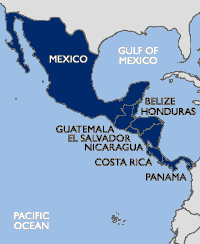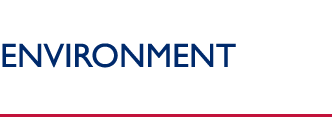E-CAM Regional Program
USAID is reducing greenhouse emissions in Central America and Mexico by supporting energy efficiency and clean production practices in the energy and industrial sectors. USAID is also securing the sustainability of protected areas through improved land use and watershed management.
Background

The USAID Central America Regional Program (E-CAM) includes the Central America and Mexico (CAM) region and is managed by USAID/El Salvador. E-CAM Program resources are focused on economic growth and development, and humanitarian assistance and crisis response. Recognizing the importance of the Central America-Dominican Republic Free Trade Agreement (CAFTA-DR), E-CAM is supporting several activities to help prepare Central American countries for the challenges related to implementation of CAFTA-DR, including cleaner production activities. As part of its economic growth activities, USAID/E-CAM is supporting management of critical watersheds, which will be achieved by securing the financial sustainability of protected areas, implementing consistent watershed management plans, and increasing the use of private voluntary mechanisms.
Sector-Specific Climate Change Activities
Reduced Net Greenhouse Gas Emissions from the Land Use Sector
Over several years, USAID has provided support to the entire Central American region – approximately 64,750,000 hectares (ha) including protected areas, to improve land use management. USAID directly improved the management of 48,123 ha in the protected areas of Consiguina Volcano, Complejo Conchagua, and Estero Padre Ramos in Nicaragua, by strengthening the management and planning capabilities of the parks’ managers.
Belize has declared 11 new protected areas and developed a National Protected Areas Strategy as a direct result of USAID efforts. Co-management policies were implemented in Honduras, Costa Rica and Nicaragua, thereby improving protected area and buffer zone management. A regional strategy for the development of private natural reserves was completed and a national policy for Private Nature Reserves was developed in Honduras. With support from USAID, El Salvador developed a National Protected Areas Law, thus providing an improved basis for enforcement. In Bocas del Toro, Panama, the Mayor requested technical assistance to develop a land use plan using participatory processes to help guarantee balanced development in the area. This strong technical base set the stage for increasing the amount of well managed forests to the current total of 1,218,137 ha.
Sustainable forestry has been actively promoted in USAID programsresulting in the certification of nine forestry concessions, totaling 88,915 ha under improved management practices. Finally, in collaboration with theRainforest Alliance, improved logging was introduced in over 1,646,770 ha of logging concessions. USAID’s success at getting Preferential Purchase Programs1 incorporated into the Nicaraguan forestry law led to increaseddemand and markets for certified timber, increasing implementation of best management practices in forest concessions.
Reduced Net Greenhouse Gas Emissions from the Energy Sector, Industry, and Urban Areas
USAID, through its Cooperative Agreement with Central American Commission for Environment and Development (CCAD), is successfully promoting policies to encourage public private partnerships for environmental protection and to develop economic incentives for environmental management throughout the region. Each CAFTA-DR country has already approved and is in the process of implementing an Energy Efficiency Regional Strategy and a Regional Clean Production Policy and Strategy. Other successful outcomes of the program include: regional mechanisms developed to promote and recognize companies that adopt cleaner production practices; training provided to 70 participants from the private and public sector, covering topics such as principles of cleaner production, certification instruments, voluntary agreements, reference centers for cleaner production and environmental management systems; and voluntary agreements being negotiated with dairy, poultry and pig farms in El Salvador and Costa Rica.
USAID support for reducing greenhouse gas (GHG) emissions from the energy sector, industry and urban areas has included a $10 million Development Credit Authority (DCA)2 loan guarantee to provide credit to small and medium size entities to invest in cleaner production technology; industrial and municipal waste reduction and recycling efforts; and pilot municipal waste methane gas recovery. This DCA loan guarantee supported clean air activities aimed at reducing sulfur emissions through the adoption of higher standards by Central American countries for imported fuels. The municipal and industrial waste reduction activity carried out national studies on select industrial wastes to identify their environmental impact and the potential for reuse.
Capacity Building Including Activities in Support of the U.N. Framework Convention on Climate Change
USAID, in collaboration with the US Environmental Protection Agency (EPA), provided a comprehensive three year GHG inventory improvement program to build a foundation for raising the quality of greenhouse gas inventories in the Central America region, and to assist in the application of the Intergovernmental Panel on Climate Change (IPCC) Good Practice Guidance. As a result, a landfill gas generation model was adapted to Central America’s solid waste circumstances, providing a tool to estimate national emissions as well as to estimate the methane generation and recovery from specific landfills. Software was developed for IPCC key source analysis, and GHG emissions from the agricultural and forestry sectors are being calculated in partnership with the Central American focal points in all seven Central American countries. Furthermore, each country worked with U.S. soil experts to improve data collection and implement higher tier IPCC methods. Forest carbon coefficients in Central America have been reviewed to improve land use change and forestry inventory estimates. The development of national GHG inventory systems throughout the Central America region is crucial to improved monitoring and verification of GHG levels and trends in emissions.
Finally, USAID, in collaboration with the U.S. National Aeronautics and Space Administration (NASA), has been supporting the SERVIR Project aimed at developing a computer architecture system to acquire, integrate and archive Landsat, MODIS, and other satellite and geographic data for the Central American region. The system has facilitated the development of regional fine-scale satellite based land cover maps which will be used as inputs to assess regional carbon stocks. Regional land cover and land use maps are being used to stimulate current and future climate change scenarios for Central America using state of the art regional and global climate models. In addition, these maps will provide input into the Global Climate Observing System (GCOS) action plan for Central America. The SERVIR system is fully operational and is providing satellite and geographic information (both raw data and derived data products) on issues such as daily fires and red tides.
Partners
USAID’s partners in climate change activities in E-CAM include:
- Central American Commission for Environment and Development (CCAD)
- Defensores de la Naturaleza
- Foundation Kukulkan
- International Resources Group
- Oak Ridge National Laboratory (ORNL)
- The Nature Conservancy (TNC)
- The Rainforest Alliance
- United States Aeronautics and Space Administration (NASA)
- United States Department of Interior (DOI)
- United States Environmental Protection Agency (EPA)
- United States Geological Services (USGS)
- Water Center for the Humid Tropics of Latin America and the Caribbean (CATHALAC)
- World Wildlife Fund (WWF)
Because partners change as new activities arise, this list of partners is not comprehensive.
Back to Top ^
|


